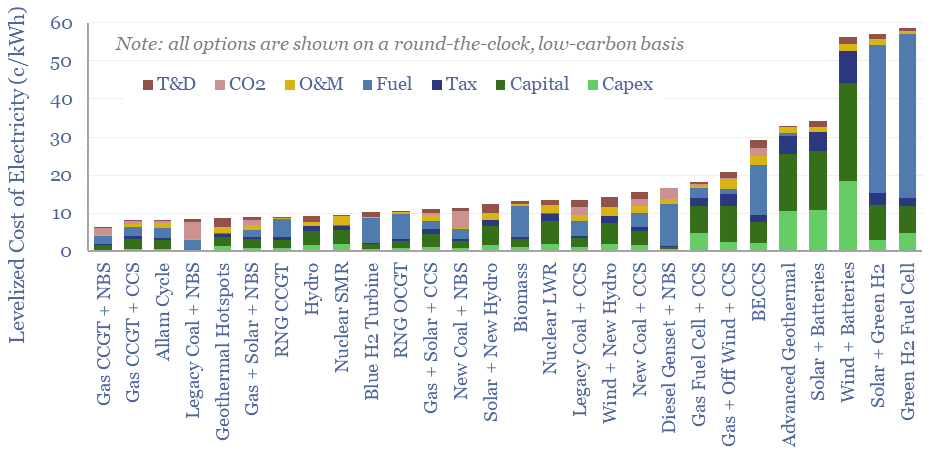This 16-page report appraises 30 different options for low-carbon, round-the-clock power generation. Their costs range from 6-60 c/kWh. We also consider true CO2 intensity, time-to-market, land use, scalability and power quality. Seven insights follow for powering new grid loads, especially AI data-centers.
Today we are increasingly receiving questions from clients looking to self-generate electricity, for large new loads, while also avoiding power grid bottlenecks. There is especially sharp demand to power new data-centers amidst the rise of AI.
Hence this report aims to compile the most extensive cross-comparison we have attempted to-date, into different sources of low-carbon baseload. We assessed 30 options across 20 different dimensions, in our LCOE database. Our methodology is described on pages 2-3.
The costs of low-carbon baseload range from 6 – 60 c/kWh. Numbers, sensitivities, capex costs, true CO2 intensities, construction times, transmission requirements, land intensity, scalability, ramp rates and reliability are all cross-plotted in the charts on pages 4-8.
Gas value chains are lowest-cost overall in the US, especially when developed directly in shale basins. Observations, discussion points and US gas market conclusions are summarized on pages 9-10.
Pure wind and solar value chains cost an order of magnitude more, when they are required to generate round-the-clock power (defined as having 3 days of battery coverage on cloudy/non-windy days). Observations and discussion points are on pages 11-13.
There are also options that use zero-hydrocarbons. They include blending wind and solar with pre-existing hydro, incubating next-generation nuclear, or housing AI data-centers alongside Iceland’s geothermal hotspots and then moving the data (!). See pages 14-15.
There is no perfect solution, however, on the quest for rapidly scalable low-carbon baseload. Hence, we close by considering whether this will delay the rise of AI, or even entrench high-carbon generation sources that would otherwise be phased out. Different options for generating low-carbon baseload reward careful consideration.
